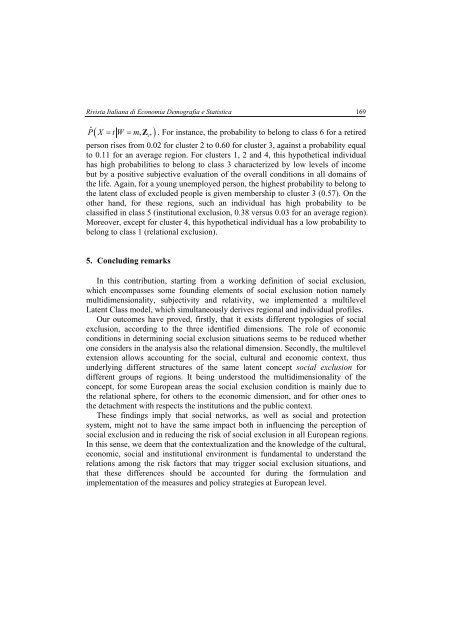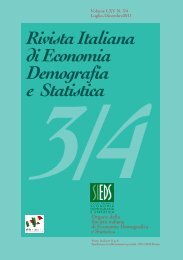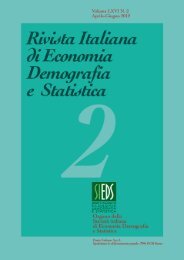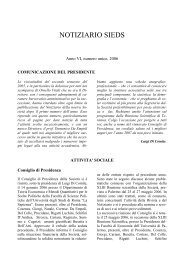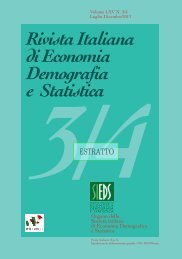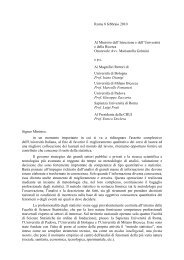rivista italiana di economia demografia e statistica - Sieds
rivista italiana di economia demografia e statistica - Sieds
rivista italiana di economia demografia e statistica - Sieds
Create successful ePaper yourself
Turn your PDF publications into a flip-book with our unique Google optimized e-Paper software.
Rivista Italiana <strong>di</strong> Economia Demografia e Statistica 169<br />
( )<br />
Pˆ X = t W = m, Z<br />
i*<br />
. For instance, the probability to belong to class 6 for a retired<br />
person rises from 0.02 for cluster 2 to 0.60 for cluster 3, against a probability equal<br />
to 0.11 for an average region. For clusters 1, 2 and 4, this hypothetical in<strong>di</strong>vidual<br />
has high probabilities to belong to class 3 characterized by low levels of income<br />
but by a positive subjective evaluation of the overall con<strong>di</strong>tions in all domains of<br />
the life. Again, for a young unemployed person, the highest probability to belong to<br />
the latent class of excluded people is given membership to cluster 3 (0.57). On the<br />
other hand, for these regions, such an in<strong>di</strong>vidual has high probability to be<br />
classified in class 5 (institutional exclusion, 0.38 versus 0.03 for an average region).<br />
Moreover, except for cluster 4, this hypothetical in<strong>di</strong>vidual has a low probability to<br />
belong to class 1 (relational exclusion).<br />
5. Conclu<strong>di</strong>ng remarks<br />
In this contribution, starting from a working definition of social exclusion,<br />
which encompasses some foun<strong>di</strong>ng elements of social exclusion notion namely<br />
multi<strong>di</strong>mensionality, subjectivity and relativity, we implemented a multilevel<br />
Latent Class model, which simultaneously derives regional and in<strong>di</strong>vidual profiles.<br />
Our outcomes have proved, firstly, that it exists <strong>di</strong>fferent typologies of social<br />
exclusion, accor<strong>di</strong>ng to the three identified <strong>di</strong>mensions. The role of economic<br />
con<strong>di</strong>tions in determining social exclusion situations seems to be reduced whether<br />
one considers in the analysis also the relational <strong>di</strong>mension. Secondly, the multilevel<br />
extension allows accounting for the social, cultural and economic context, thus<br />
underlying <strong>di</strong>fferent structures of the same latent concept social exclusion for<br />
<strong>di</strong>fferent groups of regions. It being understood the multi<strong>di</strong>mensionality of the<br />
concept, for some European areas the social exclusion con<strong>di</strong>tion is mainly due to<br />
the relational sphere, for others to the economic <strong>di</strong>mension, and for other ones to<br />
the detachment with respects the institutions and the public context.<br />
These fin<strong>di</strong>ngs imply that social networks, as well as social and protection<br />
system, might not to have the same impact both in influencing the perception of<br />
social exclusion and in reducing the risk of social exclusion in all European regions.<br />
In this sense, we deem that the contextualization and the knowledge of the cultural,<br />
economic, social and institutional environment is fundamental to understand the<br />
relations among the risk factors that may trigger social exclusion situations, and<br />
that these <strong>di</strong>fferences should be accounted for during the formulation and<br />
implementation of the measures and policy strategies at European level.


